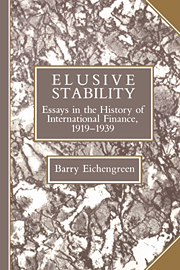Book contents
- Frontmatter
- Contents
- List of tables
- List of figures
- Acknowledgments
- 1 Introduction
- 2 Real exchange rate behavior under alternative international monetary regimes
- 3 Understanding 1921–1927: inflation and economic recovery in the 1920s
- 4 Bank Rate policy under the interwar gold standard
- 5 The Bank of France and the sterilization of gold, 1926–1932
- 6 International policy coordination in historical perspective: a view from the interwar years
- 7 The economic consequences of the franc Poincaré
- 8 Sterling and the tariff, 1929–1932
- 9 Exchange rates and economic recovery in the 1930s
- 10 The gold-exchange standard and the Great Depression
- 11 Hegemonic stability theories of the international monetary system
- References
- Index
11 - Hegemonic stability theories of the international monetary system
Published online by Cambridge University Press: 21 March 2010
- Frontmatter
- Contents
- List of tables
- List of figures
- Acknowledgments
- 1 Introduction
- 2 Real exchange rate behavior under alternative international monetary regimes
- 3 Understanding 1921–1927: inflation and economic recovery in the 1920s
- 4 Bank Rate policy under the interwar gold standard
- 5 The Bank of France and the sterilization of gold, 1926–1932
- 6 International policy coordination in historical perspective: a view from the interwar years
- 7 The economic consequences of the franc Poincaré
- 8 Sterling and the tariff, 1929–1932
- 9 Exchange rates and economic recovery in the 1930s
- 10 The gold-exchange standard and the Great Depression
- 11 Hegemonic stability theories of the international monetary system
- References
- Index
Summary
An international monetary system is a set of rules or conventions governing the economic policies of nations. From a narrowly national perspective, it is an unnatural state of affairs. Adherence to a common set of rules or conventions requires a certain harmonization of monetary and fiscal policies, even though the preferences and constraints influencing policy formulation diverge markedly across countries. Governments are expected to forswear policies that redistribute economic welfare from foreigners to domestic residents and to contribute voluntarily to providing the international public good of global monetary stability. In effect, they are expected to solve the defection problem that plagues cartels and – equivalently in this context – the free-rider problem hindering public good provision. Since they are likely to succeed incompletely, the public good of international monetary stability tends to be underproduced. From this perspective, the paradox of international monetary affairs is not the difficulty of designing a stable international monetary system, but the fact that such systems have actually persisted for decades.
Specialists in international relations have offered the notion that dominance by one country – a hegemonic power – is needed to ensure the smooth functioning of an international regime. The concentration of economic power is seen as a way of internalizing the externalities associated with systemic stability and of ensuring its adequate provision. The application of this “theory of hegemonic stability” to international monetary affairs is straightforward.
- Type
- Chapter
- Information
- Elusive StabilityEssays in the History of International Finance, 1919–1939, pp. 271 - 311Publisher: Cambridge University PressPrint publication year: 1990
- 9
- Cited by



